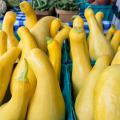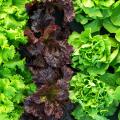Carrots
Carrots

Mississippi’s high clay content, poorly drained soils are not suited for developing long, straight carrots, so select varieties that are only 6 to 8 inches long. Carrots are sensitive to acid soils. Raised beds filled with improved soil allow you to grow carrots where they wouldn’t grow in native soil.
Carrot seeds are slow to germinate, and germination may not be uniform. Hard, packing rains following planting and before germination result in a poor stand or no stand at all. Mix some radish seeds with carrot seeds to mark the row. Carrot seeds germinate best in a warm, moist soil. Cover the planted row with clear plastic or a floating row cover to help get a good stand. Remove the plastic immediately after germination, but you can leave the polyester row cover over the seedlings until they make some growth. To aid emergence, cover the seeds with a noncrusting material like sawdust, sand, or vermiculite, and keep the newly seeded row moist. Thin seedlings to stand about 2 inches apart.
Green shoulders on carrots result from sunburn. Pull a little soil to the row when cultivating to keep carrots covered. Misshapen, twisted, and forked carrots result from clay soils, sticks, roots, stones, or root knot nematodes.
Varieties
- Danvers 126—fresh use and processing type; tolerates high temperatures; moderately tapered; stump root 6 to 8 inches long; broad shoulder; open pollinated; 75 days.
- Red Cored Chantenay—processing type; choice for heavy soils; tapered; short, thick stump root; 4 to 6 inches long; heavy shoulder; 68 days.
Publications
News
Did you know yellow squash is in the pumpkin family and are 95 percent water?
Tomatoes are a popular crop, both for commercial growers and home gardeners. Even the best tomato growers run into problems along the way! We put together a simple, easy-to-follow guide to help you spot a few of the most common tomato troubles gardeners see.
Did you know lettuce was one of the first vegetables brought to America by Christopher Columbus? What a great fun fact!




